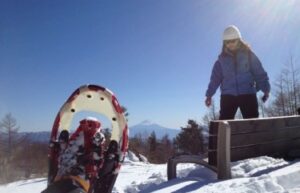Try Snowshoeing for a Great Winter Workout
If you are looking for an additional outdoor sport to add to your lineup this winter, consider picking up snowshoeing. Snowshoes are a great way to stay in shape, enjoy the great outdoors, and make the most of your local trails.

What is snowshoeing?
Snowshoeing is easy to learn and relatively inexpensive to get into. The first recorded use of snowshoes dates back almost 6,000 years. Most indigenous cultures in areas with heavy snowfall developed a snowshoe of their own. This is a testimony to their effectiveness. Each snowshoe was unique to the culture, but essentially the same in theory. The broad shoe acts like a web, allowing the wearer to float on top of the snow. The shoe distributes the wearer’s weight. This prevents the wearer from sinking deeply into the snow and makes winter walking significantly easier.
Types of snowshoes
Snowshoes come in several different styles. Aerobic, or running snowshoes, are designed for jogging on snowy trails and are not suitable for backcountry excursions. Recreational snowshoes are larger than aerobic snowshoes. These are suitable for longer walks in deeper snow. Avid outdoor enthusiasts who enjoy winter in the backcountry use mountaineering snowshoes. These are heavy-duty snowshoes designed for use off the trail in serious drifts. Mountaineering snowshoes are heavier than recreational or aerobic snowshoes and take a while to work up to.
Benefits of snowshoeing
Don’t be fooled by the idea of floating across a snowy field. Snowshoeing is a great workout. According to weightwatchers.com, a 150-pound person burns an average of 650 to 700 calories an hour while snowshoeing. That is more than the average person burns running or jogging. Snowshoeing works your entire lower body. Your glutes, quadriceps, and hip flexors all feel the burn. Adding an upper body workout is as easy as acquiring snowshoe poles.
The benefit of snowshoeing is that despite the staggering number of calories burned, it is a low impact activity. It does not wear on your joints like running or jogging. The snow lessens the impact and the very motion required for coordinated snowshoeing is easy on the body. Combined with the ease of learning, this makes snowshoeing an appropriate activity for people of all fitness levels and ages.
Snowshoeing is safer than downhill winter sports and cross-country skiing. The risk of falling is lower, especially when poles are used. Snowshoes are easier to control than skis or snowboards. It is very difficult to lose control of a snowshoe, although it takes a few practice steps to get accustomed to the extra length. Tripping over your snowshoe is the only real danger snowshoeing presents the amateur.
Where to find snowshoes
Snowshoes are sold in most outdoor equipment stores. Prices vary depending on the model and quality. Expect to pay anywhere from fifty to three hundred dollars for your first pair of snowshoes. If you are not sure you are ready to commit to owning a pair, consider renting from a nearby resort or community center.
This winter, you don’t need to worry about hitting the slopes every day. Get your outdoor workout in during the week with a pair of snowshoes and enjoy your winter wonderland while keeping off those winter pounds.